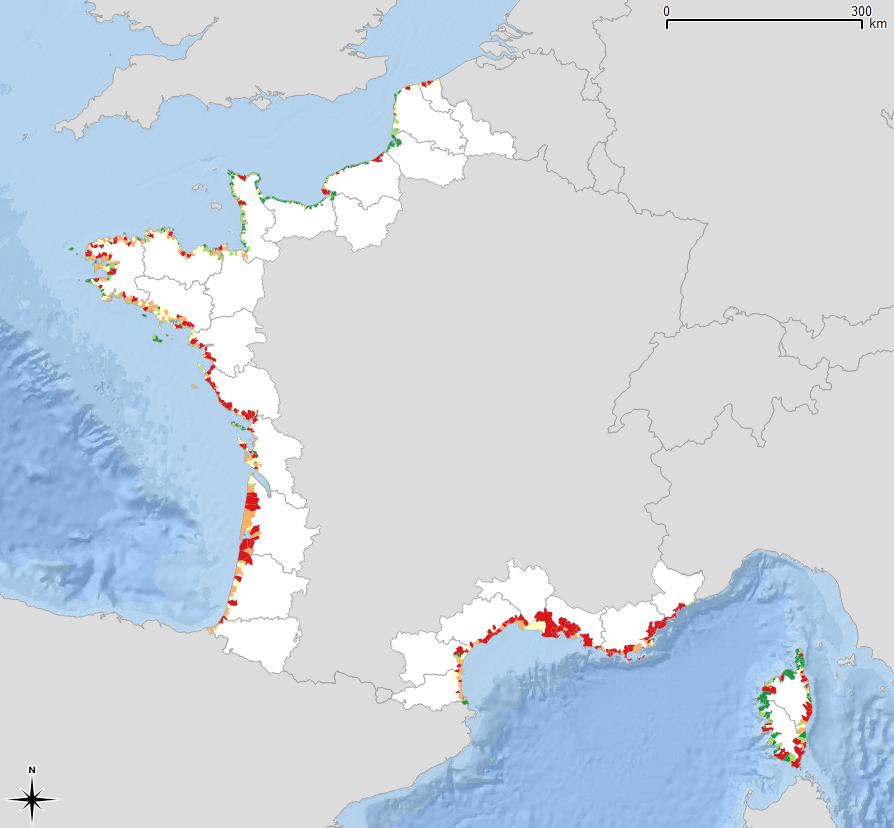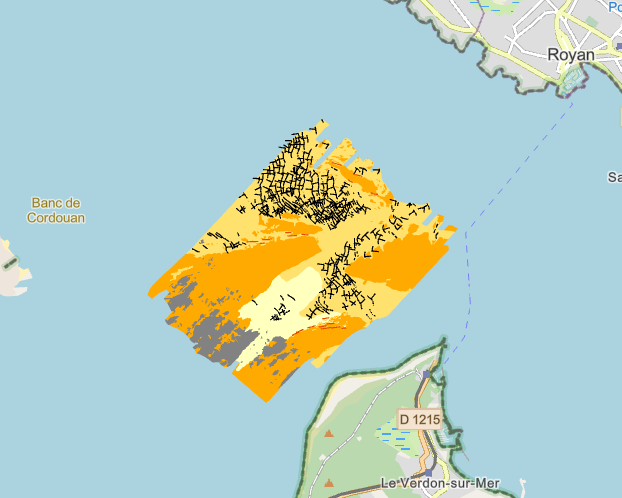10000
Type of resources
Available actions
Topics
Keywords
Contact for the resource
Provided by
Years
Formats
Representation types
Update frequencies
status
Scale
Resolution
-

The Coastal Zones LC/LU Change (CZC) 2012-2018 is providing the Land Cover / Land Use (LC/ LU) change for areas along the coastline of the EEA38 countries and the United Kingdom, between the reference years 2012 and 2018. The Coastal Zones product monitors landscape dynamics in European coastal territory to an inland depth of 10 km with a total area of approximately 730,000 km², with all the relevant areas (estuaries, coastal lowlands, nature reserves). The production of the coastal zone layers was coordinated by the European Environment Agency (EEA) in the frame of the EU Copernicus programme, as part of the Copernicus Land Monitoring Service (CLMS) Local Component. The Coastal Zones Change product covers a buffer zone of coastline derived from EU-Hydro v1.1. The Land Cover/Land Use (LC/LU) Change layer is extracted from Very High Resolution (VHR) satellite data and other available data. The reference years for the change are 2012 and 2018. The class definitions follow the pre-defined nomenclature on the basis of Mapping and Assessment of Ecosystems and their Services (MAES) typology of ecosystems (Level 1 to Level 4) and CORINE Land Cover adapted to the specific characteristics of coastal zones. The classification provides 71 distinct thematic classes with a Minimum Mapping Unit (MMU) of 0.5 ha and a Minimum Mapping Width (MMW) of 10 m. The status product is available for the 2012 and 2018 reference years. This CZC dataset is distributed in vector format, in a single OGC GeoPackage file covering the area of interest.
-
The DTM is a compilation of multibeam echosounder surveys acquired in 2013. The resolution is 1/64 arc-minutes (~30m). Surveys are located on the Capbreton Submarine Canyon (France) with depths from -4.7m to -344.9m. Depths are referenced to the Lowest Astronomical Tide and the coordinates are expressed into the WGS84 reference frame. The surveys which compose the DTM are S201306500-09 and S201306500-11. Data and metadata associated to these surveys are available on the website http://diffusion.shom.fr/pro/lots-bathy.html. The DTM is not to be used for navigation.
-

The Coastal Zones (CZ) LC/LU product for 2018 is providing a detailed Land Cover / Land Use (LC/ LU) dataset for areas along the coastline of the EEA38 countries and the United Kingdom, with reference year 2018 for the classification. This product monitors landscape dynamics in European coastal territory to an inland depth of 10 km with a total area of approximately 730,000 km², with all the relevant areas (estuaries, coastal lowlands, nature reserves). The production of the coastal zone layers was coordinated by the European Environment Agency (EEA) in the frame of the EU Copernicus programme, as part of the Copernicus Land Monitoring Service (CLMS) Local Component. The Coastal Zones product covers a buffer zone of coastline derived from EU-Hydro v1.1. Land Cover/Land Use (LC/LU) layer is extracted from Very High Resolution (VHR) satellite data and other available data. The class definitions follow the pre-defined nomenclature on the basis of Mapping and Assessment of Ecosystems and their Services (MAES) typology of ecosystems (Level 1 to Level 4) and CORINE Land Cover adapted to the specific characteristics of coastal zones. The classification provides 71 distinct thematic classes with a Minimum Mapping Unit (MMU) of 0.5 ha and a Minimum Mapping Width (MMW) of 10 m. The product is available for the 2012 and 2018 reference year including change mapping. This CZ dataset is distributed in vector format, in a single OGC GeoPackage SQLite file covering the area of interest.
-

The Coastal Zones (CZ) LC/LU product for 2012 is providing a detailed Land Cover / Land Use (LC/ LU) dataset for areas along the coastline of the EEA38 countries and the United Kingdom, with reference year 2012 for the classification. This product monitors landscape dynamics in European coastal territory to an inland depth of 10 km with a total area of approximately 730,000 km², with all the relevant areas (estuaries, coastal lowlands, nature reserves). The production of the coastal zone layers was coordinated by the European Environment Agency (EEA) in the frame of the EU Copernicus programme, as part of the Copernicus Land Monitoring Service (CLMS) Local Component. The Coastal Zones product covers a buffer zone of coastline derived from EU-Hydro v1.1. Land Cover/Land Use (LC/LU) layer is extracted from Very High Resolution (VHR) satellite data and other available data. The class definitions follow the pre-defined nomenclature on the basis of Mapping and Assessment of Ecosystems and their Services (MAES) typology of ecosystems (Level 1 to Level 4) and CORINE Land Cover adapted to the specific characteristics of coastal zones. The classification provides 71 distinct thematic classes with a Minimum Mapping Unit (MMU) of 0.5 ha and a Minimum Mapping Width (MMW) of 10 m. The product is available for the 2012 and 2018 reference year including change mapping. This CZ dataset is distributed in vector format, in a single OGC GeoPackage SQLite file covering the area of interest.
-

The Digital Terrain Model of the Bay of Biscaye and of the Channel is the result of the processing of a compilation of single and multibeam echosounder data, of DTMs and of chart countours produced before 2008 for hydrodynamic modeling.
-
Ce jeu de données localise des obstacles de franchissement pour la faune aquatique.
-
Le dispositif de mesures fixes de qualité de l'air d'Atmo Nouvelle-Aquitaine permet de répondre aux exigences réglementaires en matière de surveillance dans l'air ambiant. Les mesures sont réalisées conformément à la Directive Européenne 2008/50/CE. Le réseau minimum européen répond aux exigences européennes en matière de sites de mesures fixes (nombre, emplacement, méthodes de mesures en particulier).
-

Ces données comptabilisent les puissances électriques en termes d'énergies renouvelables reliées au réseau par communes littorales en 2009 et 2013 d'après les obligations d'achat d'EDF, EDF SEI et les entreprises locales de distribution. Les puissances électriques sont distinguées en quatre catégories : éolien, photovoltaique, hydraulique, et autres sources. Elles sont exprimées en Kwh.
-

Urban Atlas ciblé sur l'agglomération bordelaise. L'élaboration de l'Atlas Urbain européen s'inscrit dans le cadre du projet GMES (Global Monitoring for Environnement Security) Geoland2 qui correspond à la surveillance, à la protection et à la gestion durable de l'environnement. L'Urban Atlas fournit des données précises sur l'occupation du sol et l'expansion urbaine (sur la densité des zones résidentielles, commerciales et industrielles, l'étendue des zones vertes, l'exposition à des risques d'inondation et toute autre transformation urbaine) dans les 27 pays de l'Union européenne. Cette cartographie concerne les villes supérieures à 100 000 habitants telles que définies par l'Audit urbain, soit 305 agglomérations dans l'UE. Ce travail est en cours de réalisation et sera achevé en 2011. Les données seront actualisées tous les 3 ans. D'ores et déjà fin 2010, plus de 150 villes sont accessibles et 26 agglomérations sont disponibles en France.
-

Données vectorielles correspondant à la carte morpho-sédimentaire du platin de Grave, dans l'embouchure de la Gironde. Edition 1986. Echelle 1/10 000. Campagne océanographique à l'origine de cette carte : - BERNE Serge (1984) FASEC-1 cruise, RV Cote D'Aquitaine, https://doi.org/10.17600/84012111 Référence bibliographique : BERNÉ S., BRAUD F., WEBER O. (1986) - Platin de Grave (Gironde), mosaïque sonar latéral, échelle 1/5 000. 2 cartes interprétatives, échelle 1/10 000 et une notice explicative. Ed. Ifremer.
 Catalogue PIGMA
Catalogue PIGMA